RBSE Solutions for Class 6 Science Chapter 11 Simple Machine are part of RBSE Solutions for Class 6 Science. Here we have given Rajasthan Board RBSE Class 6 Science Chapter 11 Simple Machine.
| Board | RBSE |
| Textbook | SIERT, Rajasthan |
| Class | Class 6 |
| Subject | Science |
| Chapter | Chapter 11 |
| Chapter Name | Simple Machine |
| Number of Questions Solved | 38 |
| Category | RBSE Solutions |
Rajasthan Board RBSE Class 6 Science Chapter 11 Simple Machine
Intext Questions
Question 1.
Write the name of some instruments or equipment’s in the following table 11.1 that are used in order to make these tasks easier. (Page 93)
Table 11.1
| S.No. | Activities | Name of the instrument which maker it easier |
| 1. | To shift a heavy stone to another place | Crowbar (Sabbal), crane |
| 2. | To go school from home | Bicycle, auto, rickshaw |
| 3. | To sew clothes | Needle thread, sewing machine |
| 4. | To hold a hot object | Pillar |
| 5. | To park a motor cycle in a raised house | Inclined plane |
| 6. | To transport construction material in multi-story buddings | Chain pulley |
Question 2.
Visit a farmer’s or a woodcutter’s workplace and inspect axe and chheni and find out what figure they possess?
Answer:
In this there are two mutually inclined planes giving a sharp and common edge at front end and a broader and plane shape at back end. This type of figure in called as wedge shape,
Activities
Activity – 1 (Page – 95)
1. Take a heavy attache case without wheels. Slide it on the ground.
2. Take another heavy attache case with wheels slide on the ground.
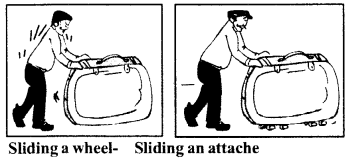
Question 1.
What difference do you feel in both the activities?
Answer:
We have to exert a large force to roll attache without wheel and a little force to roll attache with wheel.
Question 2.
Why do you need to apply force in moving the heavy attache case with out wheel?
Answer:
When we slide an attache case without wheels on the ground, the ground exerts a greater amount of frictional force on the attache case.
Activity – 3 (Page – 96)
- Put some load in a carton or box and keep one or two bricks near it.
- Place a long and strong bamboo – staff under the carton or box as shown in figure.
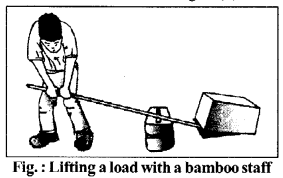
- Try to lift the carton or box.
- In this situation the distance between the carton or box and the bricks (weight arm) is less where as the distance between your hands and the bricks (effort arm) is high and you are able to lift the load easily.
- Move the bricks a little away from the carton or box and repeat this activity again.
Observation : We find that if the bricks are near our hands we have to apply more force to lift the load. Therefore if the length of the effort arm (distance between our hands and the bricks) is more then we have to apply less effort (force) to lift the load. In other words, when the length of the weight arm (the distance between the bricks and the load) is less than we have to apply more force to lift the load.
Do This Also (Page 98)
- Tie up a scale in the center taking a piece of a spoke of a bicycle wheel.
- Tie up two plastic spoons at both the ends of the scale.
- Take two old small plastic jars and fill them half with sand to make them sufficiently heavy.
- Keep these jars at a small distance from each other and fit the two ends of the spoke on these jars in such a way that they may rotate freely.
- In this way you have made your toy see – saw.
- Keep weights on the two spoons of his lever and exhibit its function.
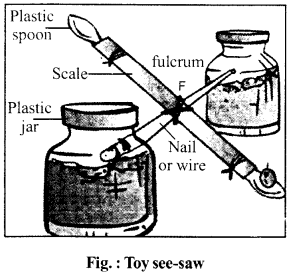
Question 1.
Is it a first order lever?
Answer:
Yes, it is a first order lever.
Question 2.
Change the position of fulcrum and lengths of the weight arm and describe the changes you noticed.
Answer:
We find different type of changes. If the length of weight arm is less and weight is more, then we find position of stable equilibrium.
Do and Observe (Page 101)
Till this point you have learnt that how, we carry out our works easily with the use of machine. If such machines are not carefully and regularly maintained and serviced they lose their ability and do not carry out their work properly. Visit your near by factory or manufacturing unit and check how the maintenance and servicing are done there. Make a list a of such methods.
Answer:
Maintenance of machines:
- Clean the machine before and after operation.
- Machine should be placed at dry place away from moisture.
- Machine should be painted to get did of rust.
- Proper oiling is necessary.
- They should be handle with care.
Exercises
Multiple Choice Questions
Question 1.
The positions of effort, fulcrum and weight in a pair of tongs are
(a) effort, fulcrum, weight
(b) fulcrum, weight, effort
(c) weight, effort, fulcrum
(d) weight, fulcrum, effort
Answer:
(c) weight, effort, fulcrum
Question 2.
Which working with the help of machines.
(a) more energy is required
(b) more force is required
(c) work is done easily and efficiently
(d) work is done with difficulty
Answer:
(c) work is done easily and efficiently
Question 3.
Which of the following is a complex machine?
(a) screw
(b) wedge
(c) sewing machine
(d) wheel
Answer:
(c) sewing machine
Question 4.
Wheels are used to move heavy objects because:
(a) they lessen gravitational force
(b) they lessen frictional force
(c) they lessen magnetic force
(d) they increase frictional force
Answer:
(b) they lessen frictional force
Fill in the blanks
1. To ………… a screw, it should be rotated clockwise.
2. The use of wheel and axle decrease ………… force.
3. Machines should be properly ……………… to increase their life and efficiency.
4. By the use of pulley, the ………….. of force gets changed.
Answer:
1. rotate
2. pulling
3. handled
4. direction
Short Answer Questions
Question 1.
Draw a w ell labelled diagram of pulley and describe its structure.
Answer:
A pulley is a small wheel with a grooved rim, A pulley is often made up of craft iron of which the central part is joined with arms through the hole of pulley. These anus are 4 or 6 six in number. This wheel (pulley) rotate around on axel which passes thought the center of gravity of the pulles and also this axel is perpendicular to the plane of the pulley.
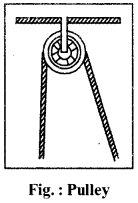
Question 2.
Write the equation of the lever principle.
Answer:
Weight × weight arm = effort × effort arm W × d = E × D
Question 3.
What is a machine ? How many type of machines are there?
Answer:
The equipment’s which are used to do any work easily, quickly and properly are known as machines. Machines can be divided in to two types simple machines and complex machines.
Question 4.
Screw and wedge are also simple machines. Explain how?
Answer:
Screw is also a simple machine because it is used to tight two parts. Wedge is also used as simple machine. Its two mutually inclined planes gives a sharp and common edge at front end and a broader and plane shape at back end.
Question 5.
Classify these object into the leaves of first, second and third order – a pair of tongs, crowbar, hand pump, nutcracker a pair of scissors, a common balance to hold a weight in hand, single wheeled barrow and pincer.
Answer:
Lever of first order – crowbar, a pair of scissors, a comman balance, hand pump pincer, lever of second order – nutcracker, single wheeled barrow. Lever of third order pair of tongs to hold a weight in hand.
Long Answer Type Questions
Question 1.
Explain through two equipment’s or instruments that with the help of machines we can do work easily and efficiently.
Answer:
- inclined plane : A plane that is used to make a difficult task easy is called an inclined plane. Apart from this the ladders often found in use at homes and the inclined paths to climb on hills all are example of inclined planes.
- Wheal and Axel : Wheel is a simple machine, wheel is one of the first inventions by humans. The wheel is often observed as an important part of complex machine.
Question 2.
W hat are levers ? State the differences between its different types with the help of examples.
Answer:
Lever is one of the simplest machines. It used to lift the heavy stone.
First order levers : In such type of lever the fulcrum (F) is situated somewhere in between the weight (W) and the effort (E).
Example : crowbar, a pliers.
Second order levers : In such a lever weight (W) is situated between fulcrum (F) and effort (E).
Example : nut cracker, fruit cutter.
Third order levers : The levers in which effort (E) is situated in between weight (W) and fulcrum (F) are called third order levers.
Example : A pair of tongs, holding weight in a hand.
Other Important Questions
Multiple Choice Questions
Question 1.
Simple machine is
(a) diesel engine
(b) electric fan
(c) lever
(d) scooter
Answer:
(c) lever
Question 2.
The operation of car, bus, scooter, train is not possible without
(a) electricity
(b) inclined plane
(c) wheels
(d) wedge
Answer:
(c) wheels
Question 3.
When we push the attache on floor, then the force acting on it
(a) rotating force
(b) frictional force
(c) electric force
(c) none of the above
Answer:
(b) frictional force
Question 4.
Axis on which wheel rotates, is called.
(a) road
(b) wedge
(c) pulley
(d) axle
Answer:
(d) axle
Fill in the Blanks
1. For operation of simple machines we use …………….. .
2. ……………. is one of the first inventions by humans.
3. …………… and axle are also simple machines.
4. A pushing wheel is a ……………… type of lever.
5. …………… is a small type of wheel.
Answer:
1. muscular force
2. wheels
3. Wheel
4. second
5. pulley
Very Short Answer Type Questions
Question 1.
What is a simple machine?
Answer:
The instruments or equipment’s which are used to do any work easily, quickly and properly are known as machines.
Question 2.
Give two example of simple machine.
Answer:
- Lever
- Wedge
Question 3.
Where do you sea inclined planes?
Answer:
- In house on street ramp
- Slope on hill road
Question 4.
What is the role of wheel in rolling a body?
Answer:
Wheel reduces the friction so there is no effort of labour.
Question 5.
Name the parts of lever.
Answer:
Fulcrum, effort, weight.
Question 6.
In which position, by applying a little fore, the work is done on lever?
Answer:
By taking long length of distance between effort and fulcrum.
Question 7.
Nutcracker is which type of lever?
Answer:
Second type.
Short Answer Type Questions
Question 1.
What are complex machines? Give examples.
Answer:
The machines which use electric motors, chains gears etc. besides simple instruments or equipment’s are called as complex machines. Examples are cycles motorcycles, sewing machine, huge factories, etc.
Question 2.
Give some examples of machines.
Answer:
- inclined plane
- wheel and axle
- lever
- wedge
- screw
Question 3.
What do you mean by wedge?
Answer:
There are two mutually inclined planes giving a sharp and comman edge at front end and a broader and plane shape at back end. This type of figure is called as wedge figure. Chheni and axe cut through wood easily because of their wedge like structure.
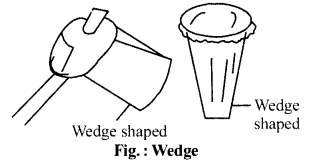
Question 4.
Pench (screw) is a simple machine. How it works ?
Answer:
It is a simple tool which is used to join (fasten) two parts, it is called a screw. It is made of a cylindrical rod of metal by cutting spring like threads over it. It has a head which can be rotated to fasten it. Generally, in order to fasten a screw one needs to rotate it in clockwise direction where as to unfasten a screw we need to rotate it in anticlockwise direction.
Question 5.
Draw a labeled diagram of a screw.
Answer:
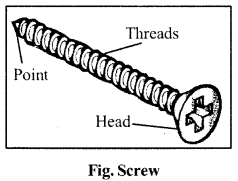
Long Answer Type Questions.
Question 1.
What is a lever ? Describe its different parts.
Answer:
Lever : lever is one of the simple machine ever used. In fig (a), a man is lifting a load with the help of a crowbar (a long, heavy and painted rod) This crowbar is an example of lever, The man applies force on one end ‘E’ of the crowbar to lift the heavy stone. This applied force is called effort force and the end ‘E’ is called effort point.
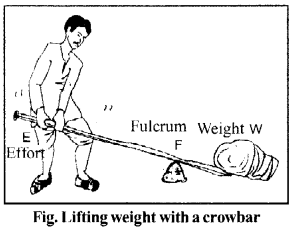
There is a small stone is the middle of the crowbar for support, this support is known as fulcrum (F). The heavy Stone on the other end of the crowbar lifts up due to the force applied by the man on ‘E’ The gravitational force is acting on the heavy stone in the downward direction. This force is called as weight (W). The distance ‘E F’ from fulcrum (F) to effort (E) is know as effort arm (D). The distance ‘FW’ from fulcrum (F) to weight (W) is known as weight arm (D)
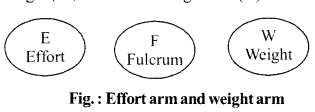
Question 2.
What is the principle of the lever? How it is easy to lift a object by a lever?
Answer:
Principle of lever: In every balanced condition the product of weight and the weight arm is always equal to the product of effort and effort arm. This principle can be represented by weight x weight arm = effort x effort arm W x d = E x D
The length of the effort arm is large which requires lesser effort for lifting a known weight. Because of this reason it becomes easier to lift or slide heavy object with the help of a crowbar. Therefore, we can say that with the help of a lever a greater force can be exerted at a point by applying a small force at some other point.
Question 3.
Describe different types of lever with labeled diagram.
Answer:
1. First order lever : Levers in which the fulcrum (F) is situated somewhere in between the weight (W) and the effort (E) are called first order levers. For example, a crowbar, a pair of scissors, a pliers.

2. Second order lever : In such levers, weight (W) is situated between fulcrum (F) and effort (E) are called second order lever. For example chopping board (karikatta) fruit cutter.
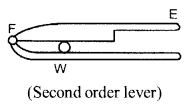
3. Third order lever : The levers in which effort (E) is situated in between weight (W) and fulcrum (F) are called third order lever, For example, A pair of tongs, holding weight in a hand.

We hope the RBSE Solutions for Class 6 Science Chapter 11 Simple Machine will help you. If you have any query regarding Rajasthan Board RBSE Class 6 Science Chapter 11 Simple Machine, drop a comment below and we will get back to you at the earliest.